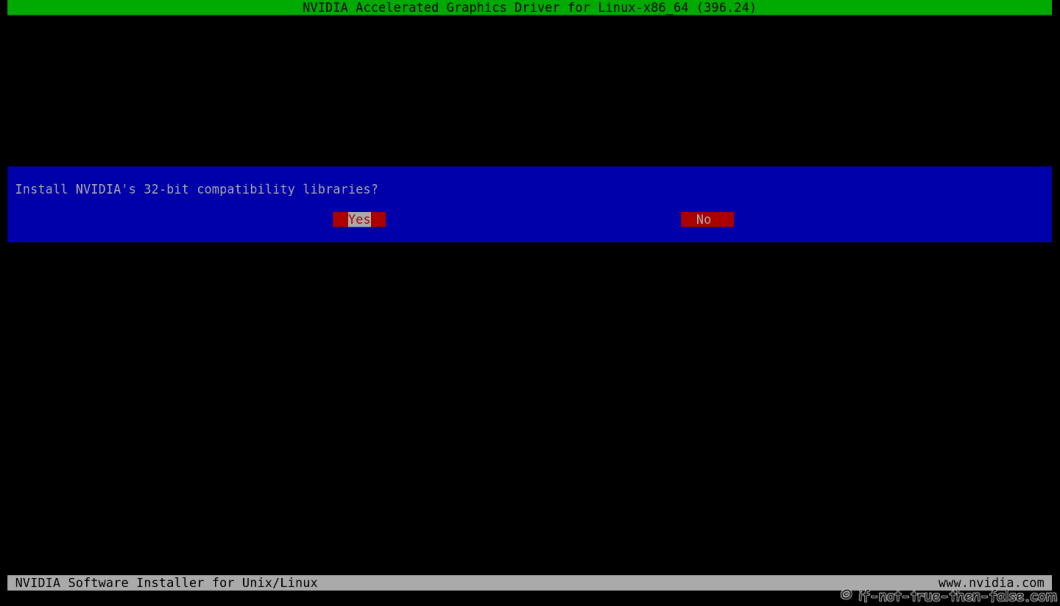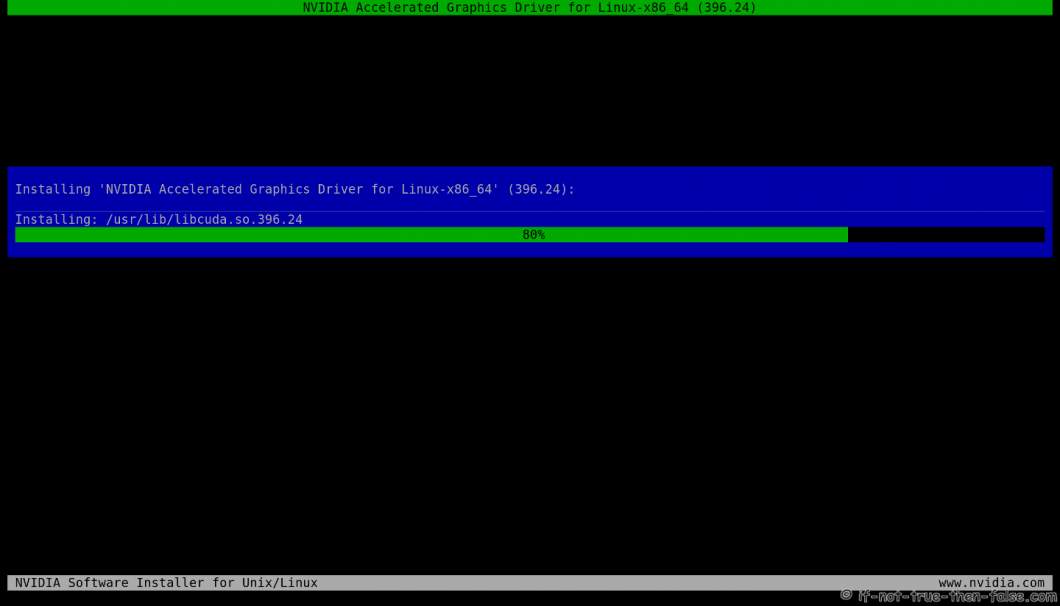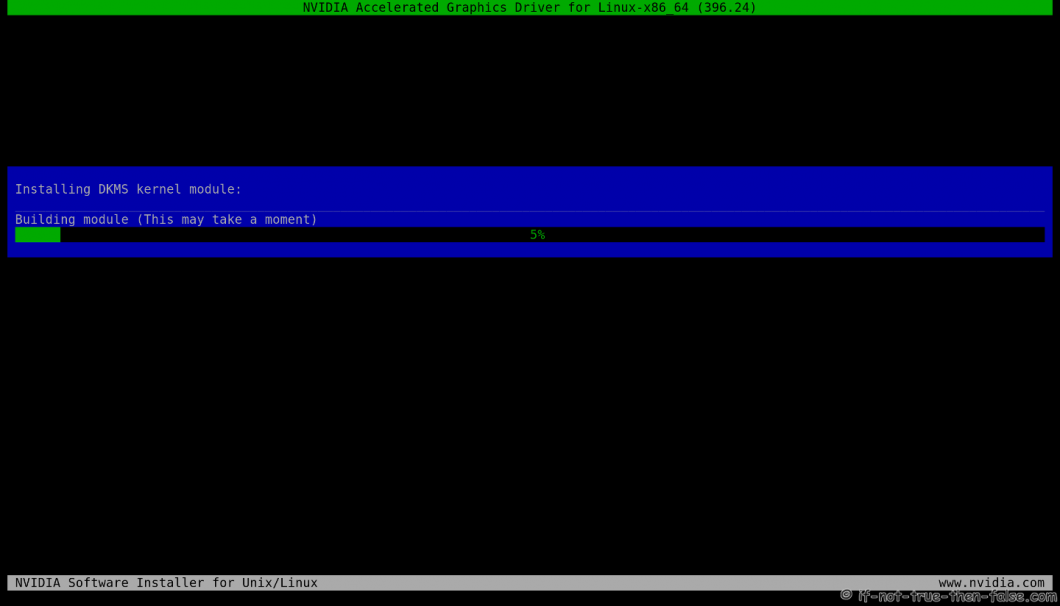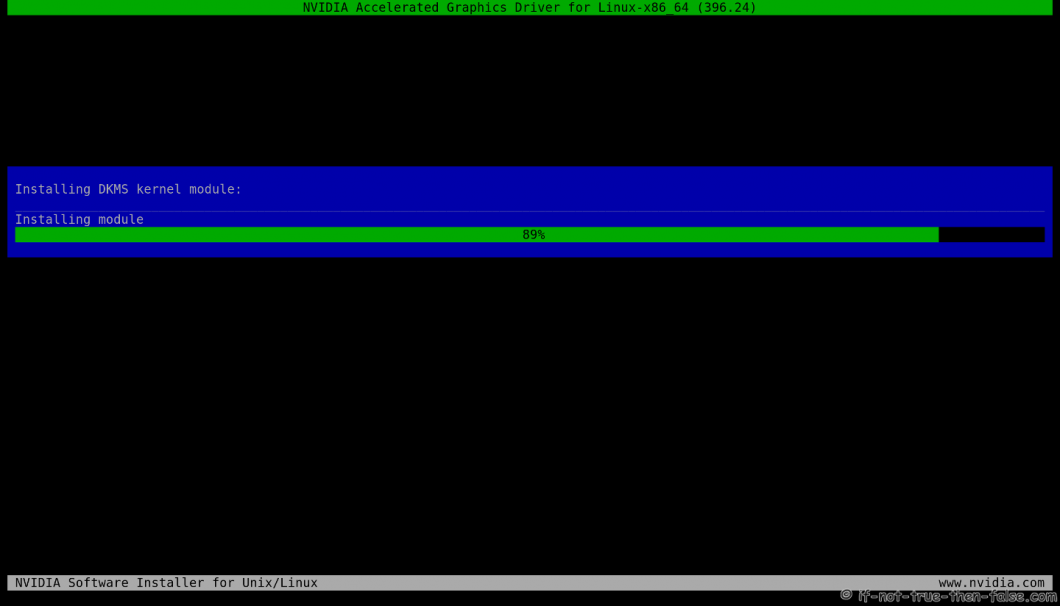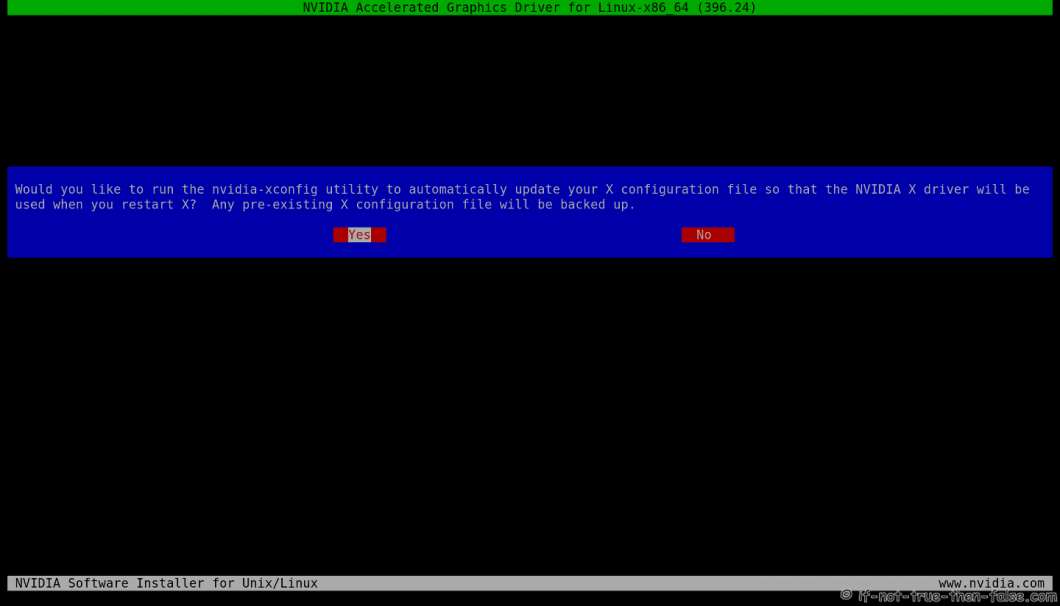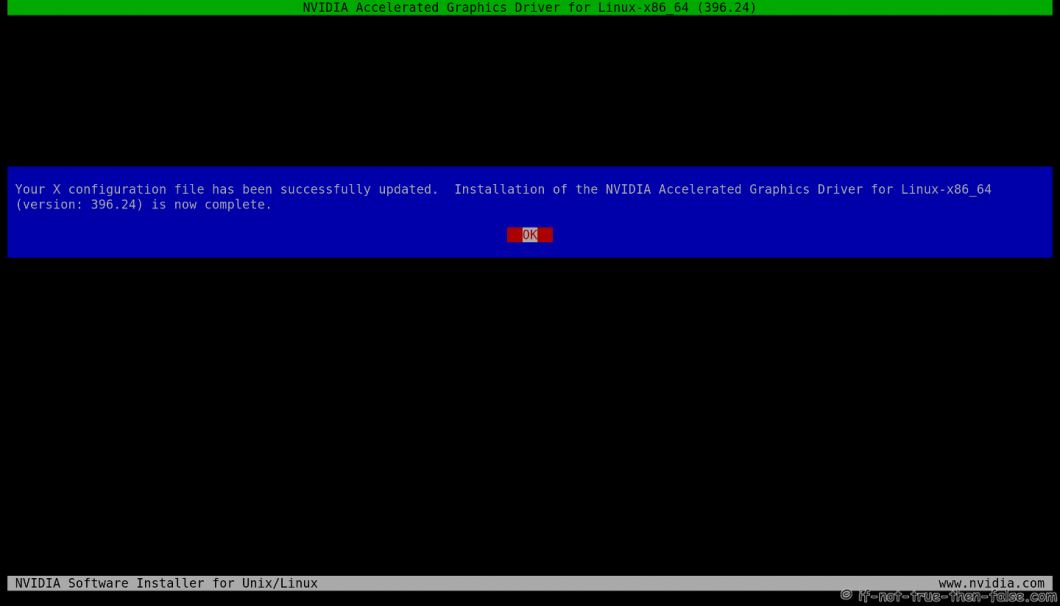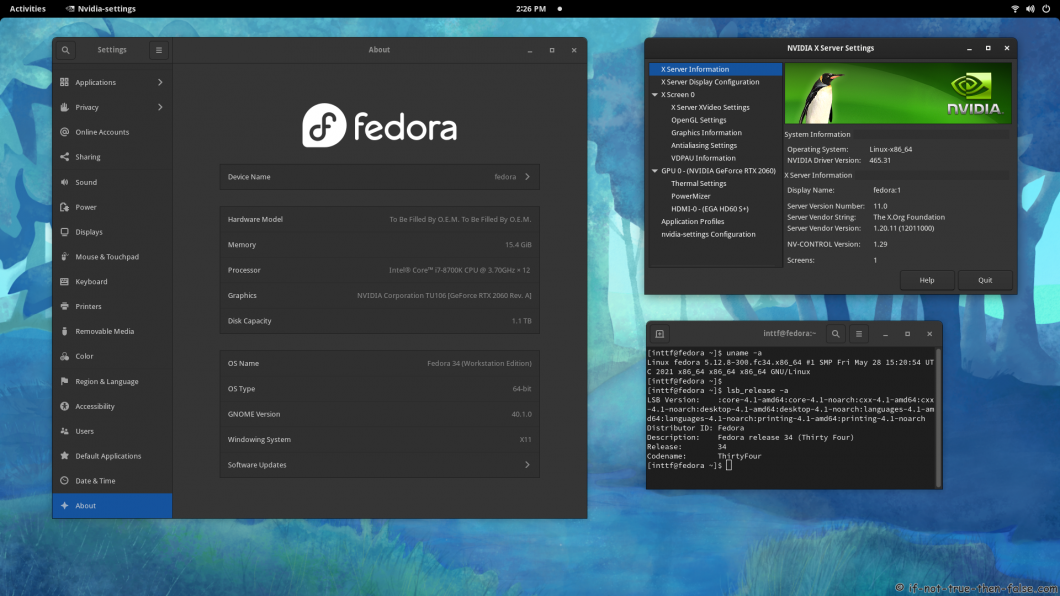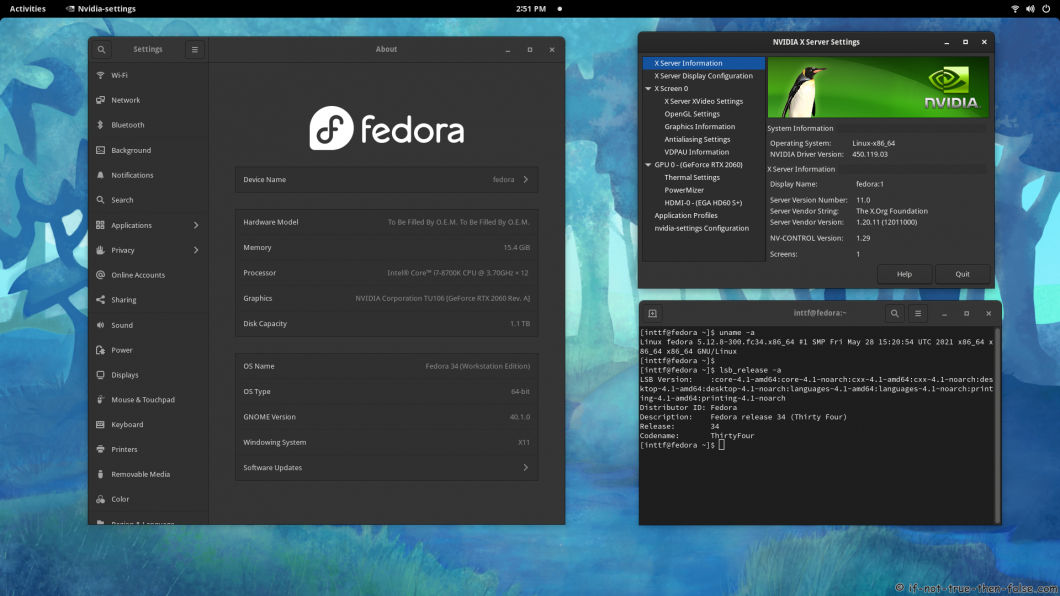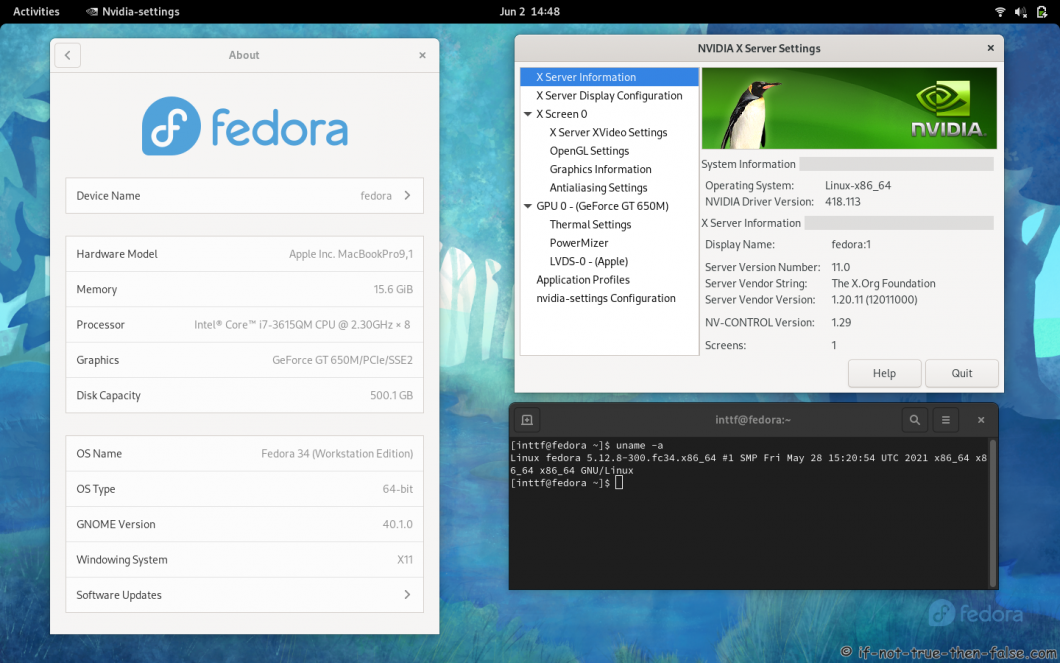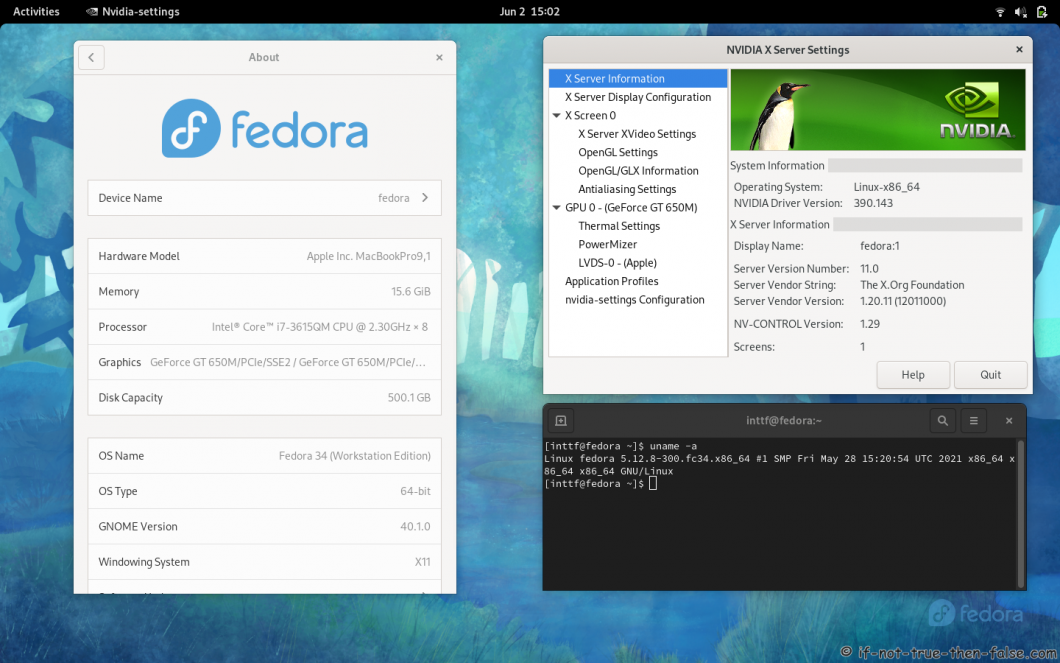- Fedora 34/33/32 NVIDIA Drivers Install Guide
- Table of Contents
- 1. Before NVIDIA drivers installation
- 1.1 Check is your NVIDIA card supported
- 1.2 NVIDIA Optimus Technology
- 1.3 Disable UEFI Secure Boot or Check Howto Sign NVIDIA Kernel Module
- 2. Install NVIDIA proprietary drivers on Fedora 33/32/31/30/29 and disable the nouveau driver
- 2.1 Download NVIDIA Installer Package
- Tested versions with 5.13+ / 5.12+ / 5.11+ / 5.10+ / 5.9+ kernels:
- 2.2 Make NVIDIA installer executable
- 2.3 Change root user
- 2.4 Make sure that you system is up-to-date and you are running latest kernel
- 2.5 Install needed dependencies
- 2.6 Disable nouveau
- 2.6.1 Create or edit /etc/modprobe.d/blacklist.conf
- 2.6.2 Edit /etc/default/grub
- 2.6.3 Update grub2 conf
- 2.6.4 Remove xorg-x11-drv-nouveau
- 2.6.5 Generate initramfs
- 2.7 Reboot to runlevel 3
- 2.8 Install NVIDIA proprietary drivers for GeForce 6/7 & GeForce 8/9/200/300 & GeForce 400/500/600/700/800/900/10/20 series cards
- 2.8.1 Log in as root user
- 2.8.2 Run NVIDIA Binary
- 2.8.3 NVIDIA Installer Register the Kernel Source Modules with DKMS
- 2.8.4 NVIDIA Installer 32-bit Compatibility Libraries
- 2.8.5 NVIDIA Installer Installing Drivers and Building kernel module
- 2.8.6 NVIDIA Installer Automatic Xorg Config and Backup
- 2.8.7 NVIDIA Drivers Installation Complete
- 2.9 All Is Done and Then Reboot Back to Runlevel 5
- 2.10 VDPAU/VAAPI support
- 3. Some Screenshots Using Different Cards and Drivers
- 3.1 NVIDIA 465.31 drivers on Fedora 34 Gnome 40 with Kernel 5.12.8
- 3.2 VIDIA 460.80 drivers on Fedora 34 Gnome 40 with Kernel 5.12.8
- 3.3 NVIDIA 450.119.03 drivers on Fedora 34 Gnome 40 with Kernel 5.12.8
- 3.4 NVIDIA 435.21 drivers on Fedora 34 Gnome 40 with Kernel 5.12.8
- 3.5 NVIDIA 418.113 drivers on Fedora 34 Gnome 40 with Kernel 5.12.8
- 3.6 NVIDIA 390.143 drivers on Fedora 34 Gnome 40 with Kernel 5.12.8
- 3.6 NVIDIA 340.108 drivers on Fedora 34 Gnome 40 with Kernel 5.12.8
- Fedora 20 nVidia Drivers Install / Uninstall / Restore Plymouth
- 1. Before nVidia drivers installation
- 1.1 Check is your nVidia card supported
- 1.2 NVIDIA Optimus Technology
- 2. Install nVidia proprietary drivers on Fedora 20 “Heisenbug” and disable the nouveau driver
- 2.1 Change root user
- 2.2 Make sure that you are running latest kernel and have latest SELinux policy packages
- 2.4 Install nVidia proprietary drivers for GeForce 6/7/8/9/200/300/400/500/600/700 series cards
- akmod-nvidia for GeForce 8/9/200/300/400/500/600/700 series cards
- akmod-nvidia-304xx for GeForce 6/7 series cards
- kmod-nvidia for GeForce 8/9/200/300/400/500/600/700 series cards
- kmod-nvidia-304xx for GeForce 6/7 series cards
- 2.5 Remove / disable nouveau drivers from kernel initramfs
- 2.6 All is done and then just reboot
- 2.7 VDPAU/VAAPI support
- 3. Restore Plymouth after nVidia drivers installation
- 3.1 First check which GRUB_GFXMODEs are supported
- 3.2 Modify /etc/default/grub
- 3.3 Backup and Regenerate your grub.cfg
- 3.4 Check available Plymouth themes
- 3.5 Install Plymouth and some Plymouth theme, example spinfinity
- 3.6 Setup spinfinity as default theme
- 3.7 Update initrd
- 3.8 Reboot and check, is it working as it should be
- 4. Uninstall nVidia proprietary drivers on Fedora 20 “Heisenbug” and enable the nouveau driver
Fedora 34/33/32 NVIDIA Drivers Install Guide
This is guide, howto install NVIDIA proprietary drivers (manually using .run files) on Fedora 34/33/32/31/30 and disable Nouveau driver. This guide works with GeForce 8/9/200/300/400/500/600/700/800/900/10/20/30 series cards.
- GeForce RTX 30 series cards works with 470.xx, 465.xx and 460.xx NVIDIA drivers, (RTX 3090, RTX 3080 and RTX 3070)
- GeForce RTX 20 series cards works with 470.xx, 465.xx, 460.xx and 450.xx NVIDIA drivers (RTX 2080 Ti, RTX 2080, RTX 2070 Ti, RTX 2070, RTX 2060)
- GeForce GT/GTX 600/700/800/900/10 series cards works with 470.xx, 465.xx, 460.xx, 450.xx and 390.xx NVIDIA drivers (GTX 1080 Ti, GTX 1080, GTX 1070, GTX 1060, GTX 1660 …)
- GeForce GT/GTX 400/500 series cards works with 390.xx NVIDIA drivers
- GeForce GT 8/9/200/300 series cards works with 340.xx NVIDIA drivers
Check video version of guide, Fedora 34 (improved version) and Fedora 33, both works with Fedora 34 and Fedora 33:
I got following question in Youtube:
It’s good question and I decided to add my answer here as well:
Actually nothing, but with manual installation you can control NVIDIA drivers versions as you wish.
You can easily install / change / test / run:
- NVIDIA New Feature Branch (NFB) drivers
- NVIDIA Long Lived Branch (LLB) drivers
- NVIDIA Short Lived Branch (SLB) drivers
- NVIDIA LEGACY drivers
- NVIDIA BETA drivers
- Install NVIDIA drivers with custom patches
- Just stay in some particular NVIDIA version
This is totally different guide than my earlier guides, like Fedora 20 NVIDIA driver install. This guide uses NVIDIA drivers directly from NVIDIA site and dkms to help on kernel updates. I decided go back to old school (and bit ugly) method and install NVIDIA drivers “manually”. I have tested this guide with 340.xx (patched), 390.xx (patched), 418.xx (patched), 435.xx (patched), 450.xx, 460.xx, 465.xx, 470.xx drivers/cards.
With DKMS, you can just update your kernel and your NVIDIA drivers are compiled automatically. If you want to upgrade NVIDIA drivers, then you have to download new installer package from NVIDIA site.
Table of Contents
Let me know, if you have some problems?
Or if you succeed, you could post output of following commands:
Backup first important files before you start installation. And this is of course at your own risk, because graphic cards, components and monitors are different and some combinations might cause totally unexpected results.
1. Before NVIDIA drivers installation
1.1 Check is your NVIDIA card supported
If you see multiple VGA controllers, then check next step and sometimes you might see example Intel VGA controller which have nothing to do with Optimus, normally you can go to BIOS and simply disable it.
1.2 NVIDIA Optimus Technology
If your lspci |grep -E “VGA|3D” output looks like following:
Or you know that your computer have NVIDIA Optimus Technology, and it is impossible to turn Intel Graphics / NVIDIA Optimus off in the BIOS then this guide might not work for you and it’s not tested. You should read this NVIDIA Optimus page first and maybe check Bumblebee Project or NVIDIA XRun Project.
1.3 Disable UEFI Secure Boot or Check Howto Sign NVIDIA Kernel Module
If you have UEFI Secure Boot enabled, then you have to disable Secure Boot or sign your NVIDIA kernel module.
2. Install NVIDIA proprietary drivers on Fedora 33/32/31/30/29 and disable the nouveau driver
2.1 Download NVIDIA Installer Package
Go to http://www.nvidia.com/Download/Find.aspx?lang=en-us and find latest version of installer package. When you use browser this is normally downloaded /home/ /Downloads/NVIDIA-Linux-xxxx.run location.
Tested versions with 5.13+ / 5.12+ / 5.11+ / 5.10+ / 5.9+ kernels:
| Fedora 34 | Fedora 33 | Fedora 32 | Fedora 31/30 |
|---|---|---|---|
| 470.74 (September 20, 2021) | 470.74 (September 20, 2021) | 470.74 (September 20, 2021) | 470.74 (September 20, 2021) |
| 465.31 (May 18, 2021) | 465.31 (May 18, 2021) | 465.31 (May 18, 2021) | 465.31 (May 18, 2021) |
| 460.91.03 (July 20, 2021) | 460.91.03 (July 20, 2021) | 460.91.03 (July 20, 2021) | 460.91.03 (July 20, 2021) |
| 450.119.03 (April 19, 2021) | 450.119.03 (April 19, 2021) | 450.119.03 (April 19, 2021) | 450.119.03 (April 19, 2021) |
| 435.21 (August 29, 2019) | 435.21 (August 29, 2019) | 435.21 (August 29, 2019) | 435.21 (August 29, 2019) |
| 418.113 (November 5, 2019) | 418.113 (November 5, 2019) | 418.113 (November 5, 2019) | 418.113 (November 5, 2019) |
| 390.144 (July 20, 2021) | 390.144 (July 20, 2021) | 390.144 (July 20, 2021) | 390.144 (July 20, 2021) |
| 340.108 (December 23, 2019) | 340.108 (December 23, 2019) | 340.108 (December 23, 2019) | 340.108 (December 23, 2019) |
Note 418.113 and 435.21 users: These are not official NVIDIA LEGACY drivers, but there is example GeForce GTX 1650 Mobile card which is not supported by older or newer drivers. (Download inttf NVIDIA patcher and patch NVIDIA-Linux-x86_64-418.113 and NVIDIA-Linux-x86_64-435.21 for Kernel 5.13+ / 5.12+ / 5.11+ / 5.10+)
Note Older Fedora users: If you have any problems with GDM (black screen). You can easily switch Display Manager example to LXDM, LightDM, SDDM or KDM.
2.2 Make NVIDIA installer executable
2.3 Change root user
2.4 Make sure that you system is up-to-date and you are running latest kernel
After update reboot your system and boot using latest kernel:
2.5 Install needed dependencies
2.6 Disable nouveau
2.6.1 Create or edit /etc/modprobe.d/blacklist.conf
Append ‘blacklist nouveau’
2.6.2 Edit /etc/default/grub
Append ‘rd.driver.blacklist=nouveau’ to end of ‘GRUB_CMDLINE_LINUX=”…”‘.
2.6.3 Update grub2 conf
Fedora 34
Fedora 33/32/31/30
2.6.4 Remove xorg-x11-drv-nouveau
2.6.5 Generate initramfs
2.7 Reboot to runlevel 3
Note: You don’t have Desktop/GUI on runlevel 3. Make sure that you have some access to end of guide. (Open it on mobile browser, Print it, use lynx/links/w3m, save it to text file).
OR alternatively you can change the runlevel on GRUB2 adding one additional parameter. Quick guide howto change runlevel on GRUB2. If you use this method, then don’t set multi-user.target and don’t set graphical.target on step 2.9 (just reboot).
2.8 Install NVIDIA proprietary drivers for GeForce 6/7 & GeForce 8/9/200/300 & GeForce 400/500/600/700/800/900/10/20 series cards
2.8.1 Log in as root user
Or alternatively change root user (you shouldn’t have nouveau and xorg loaded)
2.8.2 Run NVIDIA Binary
Following command executes driver install routine. Use full file name command if you have multiple binaries on same directory.
2.8.3 NVIDIA Installer Register the Kernel Source Modules with DKMS
2.8.4 NVIDIA Installer 32-bit Compatibility Libraries
2.8.5 NVIDIA Installer Installing Drivers and Building kernel module
Note: If you get libglvnd error, then abort installation and try this. Also “Install and overwrite existing files” works, but fixing this error is more clean way to install NVIDIA Drivers.
2.8.6 NVIDIA Installer Automatic Xorg Config and Backup
2.8.7 NVIDIA Drivers Installation Complete
2.9 All Is Done and Then Reboot Back to Runlevel 5
2.10 VDPAU/VAAPI support
To enable video acceleration support for your player (Note: you need Geforce 8 or later).
3. Some Screenshots Using Different Cards and Drivers
3.1 NVIDIA 465.31 drivers on Fedora 34 Gnome 40 with Kernel 5.12.8
3.2 VIDIA 460.80 drivers on Fedora 34 Gnome 40 with Kernel 5.12.8
3.3 NVIDIA 450.119.03 drivers on Fedora 34 Gnome 40 with Kernel 5.12.8
3.4 NVIDIA 435.21 drivers on Fedora 34 Gnome 40 with Kernel 5.12.8
3.5 NVIDIA 418.113 drivers on Fedora 34 Gnome 40 with Kernel 5.12.8
3.6 NVIDIA 390.143 drivers on Fedora 34 Gnome 40 with Kernel 5.12.8
3.6 NVIDIA 340.108 drivers on Fedora 34 Gnome 40 with Kernel 5.12.8
Let me know, if you have problems?
Or if you succeed, you could post output of following commands:
Источник
Fedora 20 nVidia Drivers Install / Uninstall / Restore Plymouth
This is guide, howto install nVidia proprietary drivers on Fedora 20 “Heisenbug” and disable Nouveau driver. This guide works with GeForce 6/7/8/9/200/300/400/500/600/700 series cards. Older GeForce series cards works with 304.xx nVidia drivers and newer 8/9/200/300/400/500/600/700 series cards works with 331.xx nVidia drivers.
Fedora 20 nVidia driver installation is not much different from previous Fedora versions. This guide is divided in three sections Install, Restore Plymouth, Uninstall I have tested this guide with a couple computers, so let me know, if you have some problems and if you succeed, you could post output of following commands:
1. Before nVidia drivers installation
1.1 Check is your nVidia card supported
List of Supported NVIDIA GPU Products, if your card found before 304.xx section, then use 331.xx drivers and if under 304.xx section, then use 304.xx drivers.
1.2 NVIDIA Optimus Technology
If your lspci |grep -i VGA output looks like following:
Or you know that your computer have NVIDIA Optimus Technology, and it is impossible to turn Intel Graphics / NVIDIA Optimus off in the BIOS then this guide is not working on your system. Check If !1 0 forums user Viger guide instead Fedora 19 for NVIDIA Optimus users (with Nvidia driver or Bumblebee). Maybe we get soon also Fedora 20 guide. 🙂
2. Install nVidia proprietary drivers on Fedora 20 “Heisenbug” and disable the nouveau driver
2.1 Change root user
2.2 Make sure that you are running latest kernel and have latest SELinux policy packages
If not then update kernel and reboot
2.4 Install nVidia proprietary drivers for GeForce 6/7/8/9/200/300/400/500/600/700 series cards
Select akmod, kmod from following.
akmod-nvidia for GeForce 8/9/200/300/400/500/600/700 series cards
akmod-nvidia-304xx for GeForce 6/7 series cards
Extra package for kernel-PAE users
kmod-nvidia for GeForce 8/9/200/300/400/500/600/700 series cards
kmod-nvidia-304xx for GeForce 6/7 series cards
akmod is good option and easy way avoid problems on kernel updates and is best and only option if you use:
- self-compiled kernel
- older Fedora kernel
- quickly changing kernels from updates-testing/rawhide
Full spec of kmod and akmod differences, check this.
2.5 Remove / disable nouveau drivers from kernel initramfs
2.6 All is done and then just reboot
2.7 VDPAU/VAAPI support
To enable video acceleration support for your player (Note: you need Geforce 8 or later).
3. Restore Plymouth after nVidia drivers installation
Note: these commands may vary if you use EFI/UEFI. So change commands accordingly.
3.1 First check which GRUB_GFXMODEs are supported
Use Grub2 shell, (press ‘c’ on Grub2), then run following commands and “pick” suitable GRUB_GFXMODE.
3.2 Modify /etc/default/grub
Add / Modify following lines on /etc/default/grub, use your own GRUB_GFXMODE.
Remember check also that you have /boot/grub2/fonts/unicode.pf2 file, if not then you can generate some Grub2 font using grub2-mkfont command, like:
3.3 Backup and Regenerate your grub.cfg
3.4 Check available Plymouth themes
3.5 Install Plymouth and some Plymouth theme, example spinfinity
3.6 Setup spinfinity as default theme
3.7 Update initrd
3.8 Reboot and check, is it working as it should be
4. Uninstall nVidia proprietary drivers on Fedora 20 “Heisenbug” and enable the nouveau driver
I assume that you installed nVidia driver with this guide, then do following.
Источник

